Serval
| Serval | |
|---|---|

| |
| A serval in Serengeti National Park | |
| Scientific classification | |
| Domain: | Eukaryota |
| Kingdom: | Animalia |
| Phylum: | Chordata |
| Class: | Mammalia |
| Order: | Carnivora |
| Suborder: | Feliformia |
| Family: | Felidae |
| Subfamily: | Felinae |
| Genus: | Leptailurus Severtzov, 1858 |
| Species: | L. serval
|
| Binomial name | |
| Leptailurus serval (Schreber, 1776)
| |
| Subspecies | |
| |

| |
| Distribution of the serval in 2015[1] | |
| Synonyms | |
The serval (Leptailurus serval) is a
It is the sole member of the genus Leptailurus. Three subspecies are recognised. The serval is a slender, medium-sized cat that stands 54–62 cm (21–24 in) at the shoulder and weighs 9–18 kg (20–40 lb). It is characterised by a small head, large ears, a golden-yellow to buff coat spotted and striped with black, and a short, black-tipped tail. The serval has the longest legs of any cat relative to its body size.
The serval is a solitary carnivore and active both by day and at night. It preys on rodents, particularly vlei rats, small birds, frogs, insects, and reptiles, using its sense of hearing to locate prey. It leaps over 2 m (6 ft 7 in) above the ground to land on the prey on its forefeet, and finally kills it with a bite on the neck or the head. Both sexes establish highly overlapping home ranges of 10 to 32 km2 (4 to 12 sq mi), and mark them with feces and saliva. Mating takes place at different times of the year in different parts of their range, but typically once or twice a year in an area. After a gestational period of two to three months, a litter of one to four is born. The kittens are weaned at the age of one month and begin hunting on their own at six months of age. They leave their mother at the age of around 12 months.
Etymology
The name "serval" is derived from (lobo-) cerval, i.e. Portuguese for lynx, used by
The name Leptailurus derives from the Greek λεπτός leptós meaning "fine, delicate", and αἴλουρος aílouros meaning "cat".[6]
Taxonomy
Felis serval was first
- Felis constantina proposed by Georg Forster in 1780 was a specimen from the vicinity of Constantine, Algeria.[8]
- Felis servalina proposed by William Ogilby in 1839 was based on one serval skin from Sierra Leone with freckle-sized spots.[9]
- Felis brachyura proposed by Johann Andreas Wagner in 1841 was also a serval skin from Sierra Leone.[10]
- Felis (Serval) togoensis proposed by Paul Matschie in 1893 were two skins and three skulls from Togo.[11]
- Felis servalina pantasticta and F. s. liposticta proposed by Reginald Innes Pocock in 1907 were based on one serval from Entebbe in Uganda with a yellowish fur, and one serval skin from Mombasa in Kenya with dusky spots on its belly.[12]
- Felis capensis phillipsi proposed by Glover Morrill Allen in 1914 was a skin and a skeleton of an adult male serval from El Garef at the Blue Nile in Sudan.[13]
The
In 1944, Pocock recognised three serval races in North Africa.[16] Three subspecies are recognised as valid since 2017:[17]
- L. s. serval, the nominate subspecies, in Southern Africa
- L. s. constantina in Central and West Africa
- L. s. lipostictus in East Africa
Phylogeny
The
The phylogenetic relationships of the serval are as follows:[2][18]
| |||||||||||||||||||||||||||||||||||||||||||
Hybrid
In April 1986, the first
Characteristics
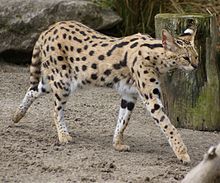
The serval is a slender, medium-sized cat; it stands 54 to 62 cm (21–24 in) at the shoulder and weighs 8 to 18 kg (18–40 lb), but females tend to be lighter. The head-and-body length is typically between 67 and 100 cm (26–39 in).
The coat is basically golden-yellow to buff and extensively marked with black spots and stripes.[21] The spots show great variation in size.[24] Facial features include the whitish chin, spots, and streaks on the cheeks and the forehead, brownish or greenish eyes, white whiskers on the snout and near the ears, which are black on the back with a white horizontal band in the middle; three to four black stripes run from the back of the head onto the shoulders and then break into rows of spots. The white underbelly has dense and fluffy basal fur, and the soft guard hairs (the layer of fur protecting the basal fur) are 5–10 cm (2.0–3.9 in) long. Guard hairs are up to 3 cm (1.2 in) long on the neck, back and flanks, and are merely 1 cm (0.39 in) long on the face.[23][26] The serval has a good sense of smell, hearing and vision.[23]
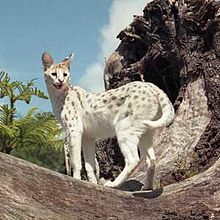
The serval is similar to the
Both leucistic and melanistic servals have been observed in captivity. In addition, the melanistic variant has been sighted in the wild,[24] with most melanistic servals having been observed in Kenya.[28]
Distribution and habitat
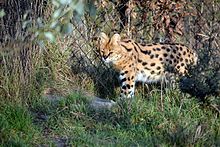
In North Africa, the serval is known only from
In Zambia's Luambe National Park, the population density was recorded as 0.1/km2 (0.26/sq mi) in 2011.[30] In South Africa, the serval was recorded in Free State, eastern Northern Cape, and southern North West.[31] In Namibia, it is present in Khaudum and Mudumu National Parks.[32]
Behaviour and ecology
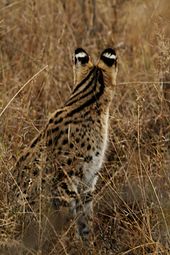
The serval is active in the day as well as at night; activity might peak in early morning, around twilight, and at midnight. Servals might be active for a longer time on cool or rainy days. During the hot midday, they rest or groom themselves in the shade of bushes and grasses. Servals remain cautious of their vicinity, though they may be less alert when no large carnivores or prey animals are around. Servals walk as much as 2 to 4 kilometres (1+1⁄4 to 2+1⁄2 miles) every night.[22][20] Servals will often use special trails to reach certain hunting areas. A solitary animal, there is little social interaction among servals except in the mating season, when pairs of opposite sexes may stay together. The only long-lasting bond appears to be of the mother and her cubs, which leave their mother only when they are a year old.[21]
Both males and females establish home ranges, and are most active only in certain regions ('core areas') within them. The area of these ranges can vary from 10 to 32 square kilometres (4 to 12 square miles); prey density, availability of cover and human interference could be significant factors in determining their size.[21][34] Home ranges might overlap extensively, but occupants show minimal interaction. Aggressive encounters are rare, as servals appear to mutually avoid one another rather than fight and defend their ranges. On occasions where two adult servals meet in conflict over territory, a ritualistic display may ensue, in which one will place a paw on the other's chest while observing their rival closely; this interaction rarely escalates into a fight.[35][36]
Agonistic behavior involves vertical movement of the head (contrary to the horizontal movement observed in other cats), raising the hair and the tail, displaying the teeth and the white band on the ears, and yowling. Individuals mark their ranges and preferred paths by
The serval is vulnerable to hyenas and African wild dogs. It will seek cover to escape its view, and, if the predator is very close, immediately flee in long leaps, changing its direction frequently and with the tail raised.[20] The serval is an efficient, though not frequent, climber; an individual was observed to have climbed a tree to a height of more than 9 metres (30 feet) to escape dogs.[24] Like many cats, the serval is able to purr;[37] it also has a high-pitched chirp, and can hiss, cackle, growl, grunt, and meow.[24]
Hunting and diet

The serval is a
The serval locates prey by its strong sense of hearing. It remains motionless for up to 15 minutes; when prey is within range, it jumps with all four feet up to 4 m (13 ft) in the air and attacks with its front paws.
Reproduction
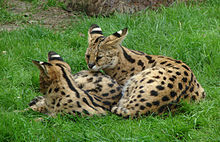
Both sexes become
Conservation
The
The serval is listed as
In culture
The association of servals with human beings dates to the time of Ancient Egypt.[42] Servals are depicted as gifts or traded objects from Nubia in Egyptian art.[43]
Servals are occasionally kept as pets, although their wild nature means that ownership of servals is regulated in some countries.[44][45][46]
References
- ^ . Retrieved 24 January 2022.
- ^ S2CID 41672825.
- ^ Buffon, G.-L. L. (1765). "Le Serval". Histoire Naturelle, générale et particulière, avec la description du Cabinet du Roi. Vol. Tome 13. Paris: Imprimerie Royale. pp. 233–235.
- ^ Harper, Douglas. "serval". Online Etymology Dictionary.
- Perseus Project.
- Perseus Project.
- ^ Schreber, J. C. D. (1778). "Der Serval". Die Säugethiere in Abbildungen nach der Natur, mit Beschreibungen. Erlangen: Wolfgang Walther. p. 407.
- ^ Forster, G. R. (1780). "LIII. Der Karakal". Herrn von Büffons Naturgeschichte der vierfüssigen Thiere. Mit Vermehrungen, aus dem Französischen übersetzt. Sechster Band [Mr. von Büffon‘s Natural History of Quadrupeds. With additions, translated from French. Volume 6]. Berlin: Joachim Pauli. pp. 299–319.
- ^ Ogilby W. (1839). "Felis servalina". Proceedings of the Zoological Society of London. 7: 94.
- ^ Wagner, J. A. (1841). "F. servalina Ogilb.". Die Säugethiere in Abbildungen nach der Natur mit Beschreibungen von Dr Johann Christian Daniel von Schreber. Vol. Supplementband 2: Die Raubthiere. Erlangen: Expedition des Schreber'schen Säugthier- und des Esper'schen Schmetterlingswerkes. p. 547.
- .
- .
- ^ Allen, G. M. (1914). "Mammals from the Blue Nile valley". Bulletin of the Museum of Comparative Zoology at Harvard College. 58 (6): 305–357.
- ^ Severtzov, N. (1858). "Notice sur la classification multisériale des carnivores, spécialement des Félidés, et les études de zoologie générale qui s'y rattachent". Revue et Magasin de Zoologie, Pure et Appliquée (2). 10: 3–8, 145–150, 193–196, 241–246, 385–393.
- OCLC 62265494.
- .
- ^ Kitchener, A. C.; Breitenmoser-Würsten, C.; Eizirik, E.; Gentry, A.; Werdelin, L.; Wilting, A.; Yamaguchi, N.; Abramov, A. V.; Christiansen, P.; Driscoll, C.; Duckworth, J. W.; Johnson, W.; Luo, S.-J.; Meijaard, E.; O’Donoghue, P.; Sanderson, J.; Seymour, K.; Bruford, M.; Groves, C.; Hoffmann, M.; Nowell, K.; Timmons, Z.; Tobe, S. (2017). "A revised taxonomy of the Felidae: The final report of the Cat Classification Task Force of the IUCN Cat Specialist Group" (PDF). Cat News (Special Issue 11): 58–60.
- ^ ISBN 978-0-19-923445-5.
- ^ Wood, S. (1986). "Blast from the Past: The Very First F1 Savannah". Lioc-Escf. 30 (6): 15.
- ^ ISBN 978-0-520-08085-0.
- ^ ISBN 978-1-4081-8996-2.
- ^ ISBN 978-0-86486-132-0.
- ^ ]
- ^ ISBN 978-0-226-77999-7.
- ISBN 978-1-4729-2285-4.
- ^ ISBN 9780521844185.
- ISBN 978-1-77007-063-9.
- ^ "Exclusive: Rare Black Wildcat Caught on Film in Africa". Animals. 22 March 2017. Archived from the original on 28 February 2021. Retrieved 8 January 2023.
- ^ Bauer, H.; Mohammed, A. A.; El Faki, A.; Hiwytalla, K. O.; Bedin, E.; Rskay, G.; Sitotaw, E. & Sillero-Zubiri, C. (2018). "Antelopes of the Dinder-Alatash transboundary Protected Area, Sudan and Ethiopia" (PDF). Gnusletter. 35 (1): 26–30. Archived from the original (PDF) on 3 July 2021.
- ^ Thiel, C. (2011). Ecology and population status of the serval Leptailurus serval (Schreber, 1776) in Zambia (PDF) (Thesis). University of Bonn. pp. 1–265.
- S2CID 131285183.
- .
- ISBN 9780824070175.
- ^ S2CID 83574432.
- ^ "Serval". The Animal Facts. Retrieved 25 April 2022.
- ^ "Serval". Altina Wildlife Park. 11 October 2017. Retrieved 25 April 2022.
- ^ Eklund, Robert. "4.2 Purring serval". Retrieved 7 March 2013.
- ^ a b Smithers, R. H. N. (1978). "Serval Felis serval Schreber, 1776". South African Journal of Wildlife Research. 8 (1): 29–37.
- .
- .
- .
- S2CID 84308532.
- ISBN 978-1-134-69293-4.
- ^ "Regulations Concerning the Private Possession of Big Cats". Library of Congress. 2013. Retrieved 6 April 2018.
- ^ "Exotic pet laws in B.C." The British Columbia Society for the Prevention of Cruelty to Animals. Retrieved 6 April 2018.
- ^ "Wild Cat Hybrid Fad in California Concerning To Pet Experts". 2013. Retrieved 6 April 2018.

